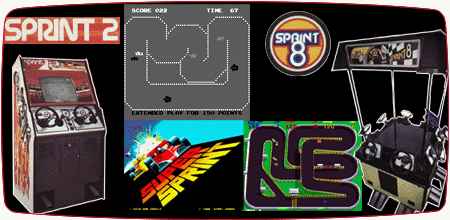Sprint series

Retro Coin Op Synopsis
Atari’s Indy 800 brought multi-player racing to the masses, but the company’s Sprint series took the genre to the next level, offering greater speed, multiple tracks, better controls, and for the first time, computer opponents.
Two Sprint games were released in 1976, the eight-player Sprint 8 and a more compact two-player version, Sprint 2. In both, the game basics remained the same as in the Indy games: Seen from an overhead perspective, cars ran laps around a track, earning points for each lap completed before time ran out. But unlike Indy 800 or is follow-up, Indy 4, the Sprint games offered a selection of tracks—four for Sprint 8, twelve for Sprint 2.
Sprint 8 kept all the 8-player action of Indy 800, but instead of eliminating cars when fewer than eight players joined in, the game turned the remaining vehicles into computer-controlled drones. That way, even a one-player game could have all the traffic-dodging excitement of a full-blown tournament.
Sprint 2 also had drone cars, but these appeared regardless of how many players took the wheel. In a two-player game, two extra drones harassed the black and white player cars, and in a one-player contest, the black car was also computer-controlled. Sprint 2’s other major selling point was its new four-speed shifter, giving players a more realistic control over their lap-driving Formula 1 racers.
1977 brought the release of Sprint 4, which, not surprisingly, was a four-player version of the game. With ten new tracks to choose from, the game offered a fresh challenge to Sprint veterans. Sprint 4 retained the manual shifter from Sprint 2, but replaced that game’s black and white graphics with color-coded cars and player scores.
In 1978, Atari released Sprint 1. While a one-player version of a popular multi-player game may not seem like an upgrade, Sprint 1 added a new level of complexity. The three previous Sprint incarnations all had multiple tracks, but once a course was chosen, that was it for the rest of the game. Sprint 1 actually changed tracks during the game itself, switching courses after every one or two laps, depending on the operator’s setting. With 12 tracks appearing randomly throughout the timed game, Sprint 1 was an entirely new spin on the time-tested racing formula.
The Sprint series was a rousing success for Atari, capturing the spirit of competitive racing in the best way possible at the time. The series went on hiatus after Sprint 1, but the concept was too golden to stay retired.
In 1986, the franchise was reborn with two games, Super Sprint and Championship Sprint. Super Sprint was first off the line, offering eight new tracks of rubber-burning action. The game still took place on tracks seen from an overhead view, but advancements in game graphics allowed the new tracks to feature elements that would have been impossible in the 70’s Sprint games: ramps, underpasses, overpasses, spirals, banked curves, opening and closing gates and more. The new tracks were all selectable from the starting screen, each ranked according to difficulty.
Instead of a race against the clock, Super Sprint allowed up to three players to keep competing until they were beaten by one of the game’s drone cars. Once a track was completed (four laps per race), the game moved on to the next, but not before showing off one of Super Sprint’s other new features…
During every race, a golden wrench would appear at some point along the track. The car that ran over it added it to his store of wrenches, which could be traded in for vehicle improvements. In between races, after bonus points had been awarded to the winners, players could exchange three wrenches for higher top speed, faster acceleration, better traction or quicker recovery from crashes. Bonus wrenches were also awarded for starting the game on one of the more difficult tracks.
Super Sprint was another hit addition to the long-running franchise, and Atari followed up its success with Championship Sprint later that year. The smaller cabinet was designed for two-player racing, but aside from that, everything that had made Super Sprint such a success remained intact. Five new tracks were added to three Super Sprint carryovers, and a few of these offered tempting, but dangerous shortcuts (broken track sections, jerry-rigged jumps, etc.)
With six games and eleven years of innovation to its credit, the Sprint series remains one of the most durable and popular franchises in the relatively brief history of racing games. Later years brought networked cabinets, first-person 3-D worlds, force feedback steering and other advancements, but despite their technical simplicity, Sprint 8, Sprint 2 and their descendants haven’t lost any of their competitive adrenaline.
Arcade Machine Release History
1976 - Sprint 81976 - Sprint 2
1977 - Sprint 4
1978 - Sprint 1
1986 - Super Sprint
1987 - Championship Sprint
